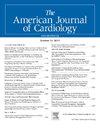Fitness and Mortality Outcomes Associated With Supramaximal Peak Heart Rate on Treadmill Exercise Stress Testing
IF 2.3
3区 医学
Q2 CARDIAC & CARDIOVASCULAR SYSTEMS
引用次数: 0
Abstract
Inability to reach age-predicted peak heart rate (APPHR) on treadmill exercise testing (TMET) is associated with lower fitness and increased mortality. The significance of a “supramaximal” heart rate (≥105% of APPHR) is poorly understood; as such, we sought to investigate this relationship. We queried the Mayo Stress database from 1993 to 2010 for patients >30 years old without cardiovascular disease and not on antichronotropic therapy. Patients were stratified into groups based on APPHR: <75%, 75% to 84%, 85% to 94%, 95% to 104%, and ≥105%, with 105% to 114% and ≥115% subgroups. Functional aerobic capacity (FAC) was assessed by ANOVA and all-cause mortality by cox hazard regression; we adjusted for confounders. In total, 18,961 patients were included; 1150 (6.1%) died. 2,144 (11.3%) of patients achieved submaximal APPHR (<85%), 2,917 achieved supramaximal APPHR (≥105%). Patients with submaximal APPHR had significantly lower FAC: 76.4% (p <0.0001) [<75%], 83.5% (p <0.0001) [≥75% to <85%]. Those with supramaximal APPHR had significantly higher FAC: 102.0% (p <0.0001). Patients with submaximal APPHR had significantly higher mortality risks: <75% (adjusted HR 2.36 [1.83 to 3.04], p <0.0001) and ≥75 to <85% (adjusted HR 1.93 [1.62 to 2.31], p <0.0001). Those with supramaximal APPHR, after adjustment for cardiac risk factors and resting heart rate, had significantly lower mortality risk (adjusted HR 0.83 [0.70 to 0.99], p = 0.0414). In conclusion, supramaximal heart rate on TMET was associated with significantly higher FAC and lower all-cause mortality risk.
跑步机运动压力测试中与最高峰值心率相关的健康和死亡率结果。
在跑步机运动测试(TMET)中,无法达到年龄预测的峰值心率(APPHR)与较低的健康水平和较高的死亡率有关。“超最大”心率(APPHR≥105%)的意义尚不清楚;因此,我们试图调查这种关系。我们查询了1993-2010年梅奥压力数据库中0 - 30岁无心血管疾病且未接受抗变时治疗的患者。根据APPHR对患者进行分组:
本文章由计算机程序翻译,如有差异,请以英文原文为准。
求助全文
约1分钟内获得全文
求助全文
来源期刊

American Journal of Cardiology
医学-心血管系统
CiteScore
4.00
自引率
3.60%
发文量
698
审稿时长
33 days
期刊介绍:
Published 24 times a year, The American Journal of Cardiology® is an independent journal designed for cardiovascular disease specialists and internists with a subspecialty in cardiology throughout the world. AJC is an independent, scientific, peer-reviewed journal of original articles that focus on the practical, clinical approach to the diagnosis and treatment of cardiovascular disease. AJC has one of the fastest acceptance to publication times in Cardiology. Features report on systemic hypertension, methodology, drugs, pacing, arrhythmia, preventive cardiology, congestive heart failure, valvular heart disease, congenital heart disease, and cardiomyopathy. Also included are editorials, readers'' comments, and symposia.
 求助内容:
求助内容: 应助结果提醒方式:
应助结果提醒方式:


